Have you ever sent a friend a travel Reel on Instagram with the words, “we should go here someday”? Maybe it was a snowy cabin in Lapland, a cliffside villa in Amalfi, or a cozy cottage under the Northern Lights.
Expedia’s new AI Trip Matching feature takes that moment of shared wanderlust and turns it into something actionable. By simply sending a Reel to Expedia’s Instagram account, travelers can now receive a customized itinerary, complete with destination insights, hotel suggestions, and activities, right inside their DMs.
It’s a frictionless experience, but also a meaningful one. Because rather than trying to change user behavior, Expedia is quietly reshaping infrastructure to meet travelers where they already are.
This article is part of our ongoing series exploring how AI is reshaping guest discovery, search, and conversion across the major OTAs.
How Trip Matching Works
Here’s how it played out in practice. I sent a Reel showing Lapland to Expedia via Instagram DM. Within seconds, the AI responded:
“Magical Lapland, your winter wonderland.”
It then offered the best time to visit (December to March), a snapshot of key activities, and a section labeled “Expedia’s Hidden Gems.” Below that, a carousel of properties appeared, each displaying a photo, price per night, rating, and number of reviews, plus a Book with Expedia button.
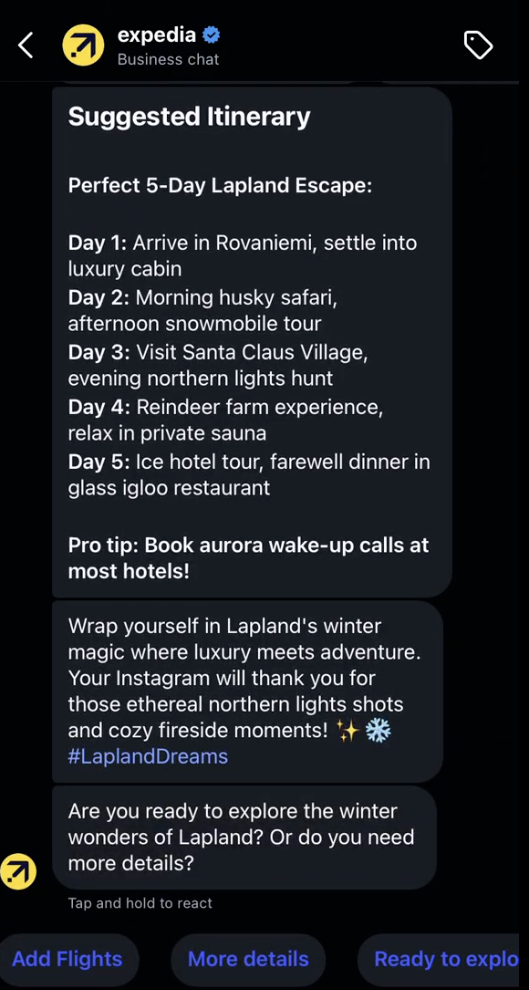
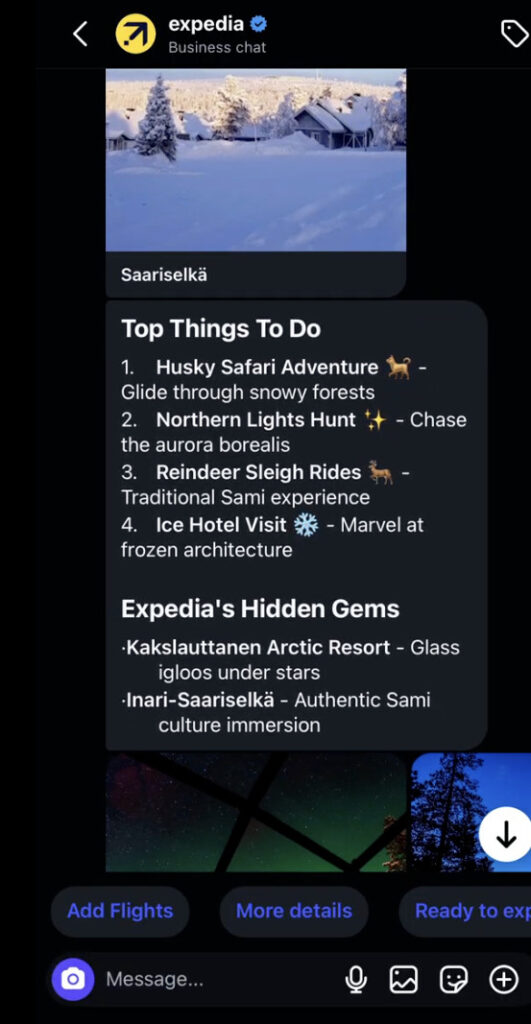
It felt like a miniature booking interface unfolding entirely inside chat.
Not a Behavioral Shift, an Infrastructural One
People’s travel behavior hasn’t changed overnight. They’ve already been discovering destinations on Instagram, Pinterest. and even TikTok for years. What Expedia has done here is build a bridge between social discovery and travel infrastructure.
The problem Expedia is solving isn’t a lack of inspiration; it’s the gap between inspiration and action. Until now, travelers would save a Reel, then open multiple tabs to figure out where that place actually was, what it was called, and how to get there. Expedia’s Trip Matching closes that gap, inserting itself into the middle of the process, the moment between dreaming and deciding.
In essence, Expedia is building infrastructure inside inspiration.
What Travelers See And What That Reveals
Inside the DM, each property card functions as a self-contained micro-listing:
- One lead photo: the emotional hook.
- A clear price per night: inclusive of taxes and fees.
- A star rating and review count: immediate trust signals.
But what determines which listings appear here? That’s the key question, and the answer likely isn’t simple.
Performance metrics almost certainly play a role: strong visuals, good reviews, and high conversion rates are the foundations of Expedia’s ranking system. But this may also include other signals, such as data from Expedia Group’s internal quality tiers, in keeping with Vrbo’s recent move to tighten visibility through a milestone-based quality structure.
And as this matures, a paid layer seems inevitable; sponsored placements within conversational AI interfaces are already being tested elsewhere in Google’s AI Overviews and ads are a being part of the Expedia offer to its ‘partners’.
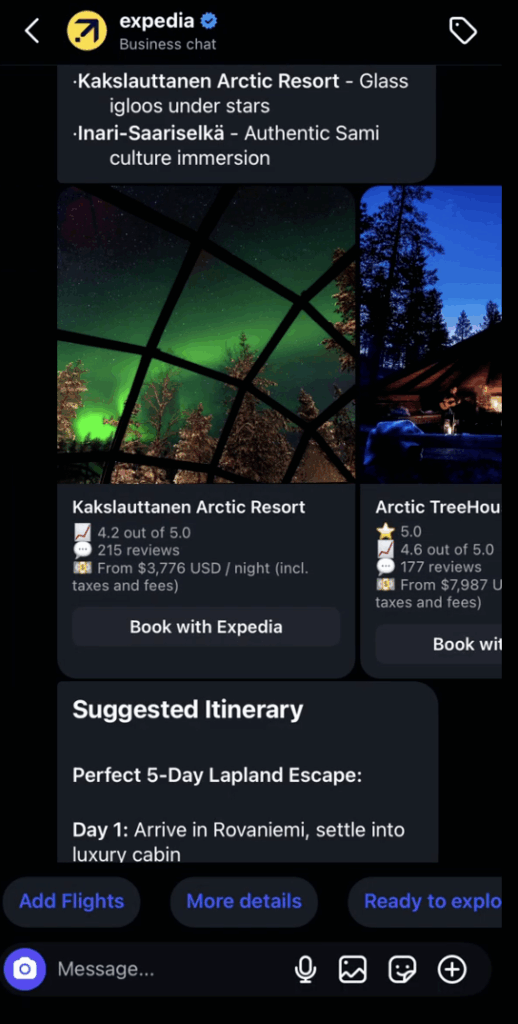
Even beyond that, two factors will likely define long-term visibility in this format:
- Relevance to traveler intent: how well your property fits the context of the query or visual cue.
- Optimization for AI discovery: whether your listing data is structured and complete enough for the system to recognize that relevance.
In other words, this isn’t just about performance; it’s about being legible to AI.
Personalized Discovery in Action
To see how adaptive it could be, I told Expedia:
“We’re a group of five, including two children under six. Where should we stay?”
The AI adjusted immediately. The results shifted to family-friendly options: resorts and lodges that highlighted kid-friendly amenities. Each result included short descriptors (“spacious cabins,” “family room with sauna,” “glass igloos,” “sleeps five”) that made suitability obvious at a glance.
This was subtle but significant: the AI wasn’t just swapping destinations; it was reframing recommendations through context.
For a parent planning a trip, that’s genuine value.
For a property manager, it’s a reminder that the more explicit and well-tagged your amenities are, the more likely AI is to match your property to the right traveler profile.
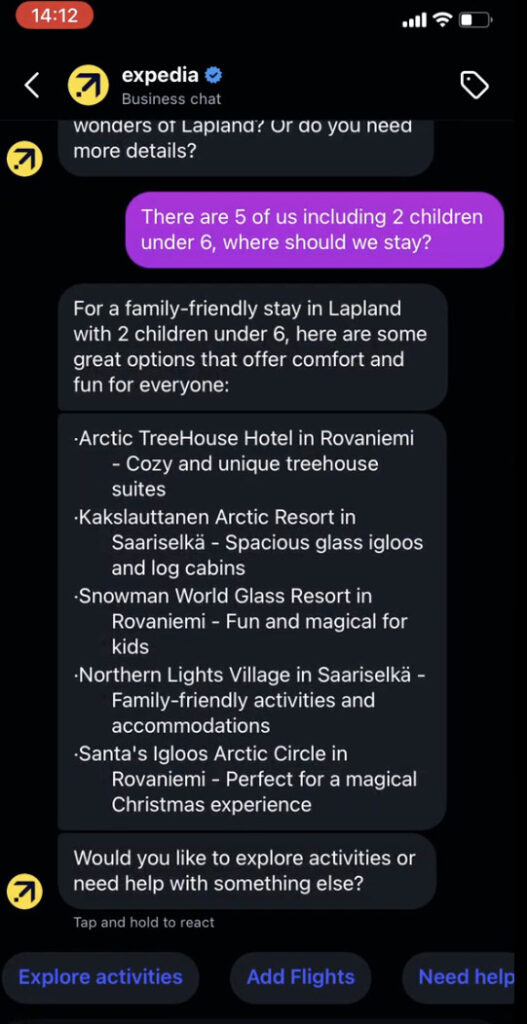
How the AI Reads the Reel
When you send a Reel, the AI likely uses a mix of visual landmark recognition, geotag inference, and caption or hashtag analysis to identify where it was filmed.
For example, in the Lapland Reel, it may have recognized distinctive features, like Santa Claus Village, reindeer, or snow-covered pines, that appear frequently in tagged Lapland content.
Once it identifies the location, Expedia’s AI taps into its Travel Graph, a constantly updated data network of hotels, rentals, and activities, to generate itinerary ideas. This connects the emotional hook of the Reel to the operational layer of travel planning.
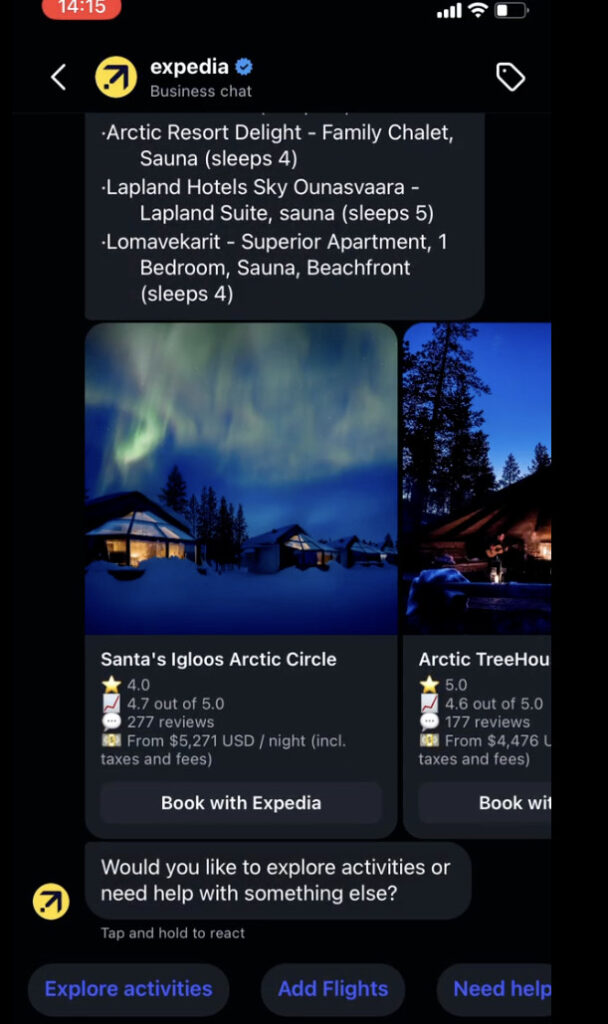
It’s a reminder that in the future, every piece of visual content could be an entry point into a booking system.
Limitations and Friction
For all its promise, the system still has clear limits.
You can’t actually book through chat. Clicking Book with Expedia opens a browser window. Worse, in our test, every link defaulted to a general U.S. results page (New Jersey, in this case) rather than the intended Lapland, or other searched destination listings.
That’s a major UX flaw, and one that highlights how early this technology still is. The intent is there, but the infrastructure isn’t fully aligned yet.
Still, even in this state, Trip Matching offers a clear preview of what’s coming: conversational, multimodal trip planning integrated directly into the platforms where travelers already spend their time.
Why It Matters for Short-Term Rental Managers
Expedia’s experiment signals something much larger than a new feature: it’s the start of AI-native discovery for travel.
For property managers, that comes with both opportunity and responsibility.
1. Context decides visibility.
Your listing will appear not just because it’s high quality, but because it’s relevant to what the traveler has seen or asked. A family-focused Reel might surface family villas; a luxury travel Reel might prioritize boutique rentals.
2. AI-readiness matters.
The better your data — high-resolution photos, descriptive captions, clear amenity listings — the easier it is for AI to connect your property to those contexts.
3. Legal transparency builds trust.
Transparent, all-inclusive pricing isn’t just regulatory compliance anymore. It ensures consistency between what the AI shows and what travelers see once they click through.
4. Expect an ad layer.
Just as Vrbo and Airbnb reward quality and engagement with higher visibility, it’s likely that Expedia will monetize this conversational discovery layer. Properties that meet certain performance or spend thresholds may get premium placement.
The Larger Shift
Trip Matching isn’t about changing how people dream. It’s about changing how those dreams turn into decisions.
It’s an infrastructural evolution, not a behavioral one. Expedia is embedding booking logic inside inspiration platforms, ensuring it remains relevant in a world where travelers start their journeys in feeds, not search bars.
For professional short-term rental managers, this means visibility begins long before a booking inquiry. The journey now starts when someone watches a Reel, and the AI decides whose property fits that story.
The Takeaway
Expedia’s Trip Matching feature offers a clear signal of where the industry is heading: AI will live where discovery happens, not where booking traditionally took place.
For guests, it’s a step toward effortless, conversational planning. For property managers, it’s a call to ensure that listings aren’t just well-presented, but intelligently structured, contextually relevant, and ready to be found by algorithms as much as by humans.
Because in this new landscape, your next booking might begin in someone else’s Reel.
📹 Watch the full walkthrough:
See how Expedia’s Trip Matching works in real time — and what it reveals about how AI is reshaping the journey from inspiration to booking.
Uvika Wahi is the Editor at RSU by PriceLabs, where she leads news coverage and analysis for professional short-term rental managers. She writes on Airbnb, Booking.com, Vrbo, regulations, and industry trends, helping managers make informed business decisions. Uvika also presents at global industry events such as SCALE, VITUR, and Direct Booking Success Summit.










